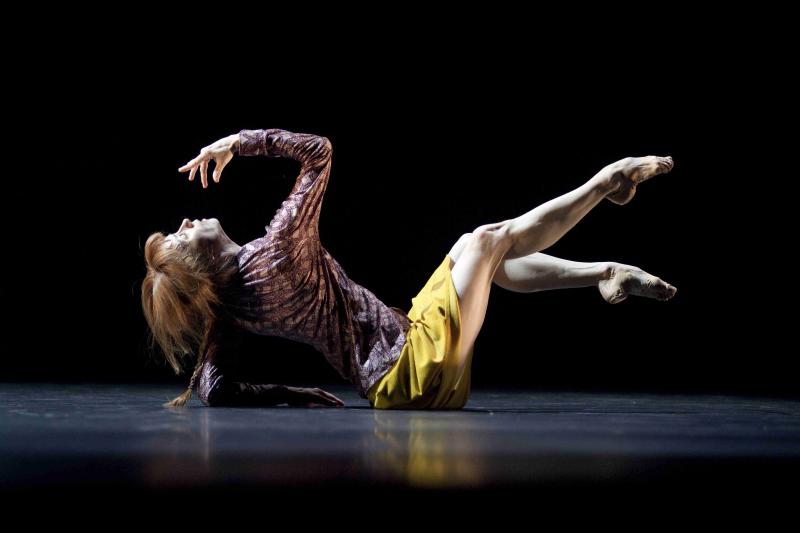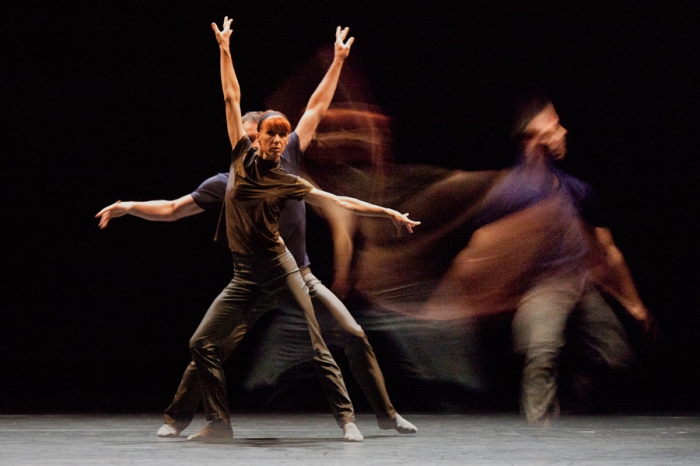6000 Miles Away, Sylvie Guillem, Birmingham Hippodrome | reviews, news & interviews
6000 Miles Away, Sylvie Guillem, Birmingham Hippodrome
6000 Miles Away, Sylvie Guillem, Birmingham Hippodrome
The French ballerina is still luminous on a flying visit to the Midlands

When Sylvie Guillem became, at 19, the youngest person ever to reach the top rank of the Paris Opéra, she gained a job title – étoile (star) – that uncannily captured her essence. Most companies call their top dancers principal or prima ballerina or soloist, titles that show they have first place among their peers. Sylvie too stands out among her peers, blessed as she is with an extraordinary body, an extraordinary work ethic, an extraordinary intelligence.
That’s not to say that she’s perfect, nor that everything she does is perfect; she’s a human being. But the pieces she chooses to dance are always worth engaging with, because they have proceeded from that fire, been scrutinised by that intelligence, forged by that work ethic, and not least because they are animated by that body, which at 49 is still astonishing. This week, the International Dance Festival in Birmingham played host to two performances of her 2011 solo (ish) show, 6000 Miles Away, a triple bill of serious pieces by contemporary choreographers Jiří Kylián, William Forsythe and Mats Ek.
Kylián’s 27’52” is a decidedly mixed affair. With almost no set (the lino on the floor gets to move, slightly), almost no costumes (two pairs of trousers and, sometimes, one top) and a discomfiting soundtrack of slow-bowing high strings, opaque sentences in French and German, and metallic percussion (like someone beating a garage door with a crowbar), it offers little that’s immediately enticing or likeable. The relationship it shows us between dancers Aurélie Cayla and Lukas Timulak is at worst an unhappy, oppressive one, and clichéd at that (Cayla runs desperately back and forth: she must feel trapped!) Timulak’s dancing lacks spark, and a very unfortunate facial resemblance to Vladimir Putin makes the hard-faced and often rough character he plays even more unsympathetic.
And yet, and yet: there is interest here. Cayla has to dance topless for a while; the visual parity this sets up between her and the bare-chested Timulak blurs the conventional gender-binaries of duets like this. Cayla often falls (cliché alert! weakness!) but always with self-possession; her character has more grit than we think, and she moves gorgeously, with a control and airy fluency that makes it look like she’s hanging in the air, in slow motion.
Forsythe’s Rearray, the next piece, is more of the same: an intense, stony-faced duet against a black backcloth between dancers in clothes so ordinary they barely count as costumes. This time it’s Guillem and Massimo Murru who have a relationship to work out, expressed through Forsythe’s incredibly cerebral dissection of classical ballet tradition. The problem is that tradition is so rarefied that only a handful of people in the world are equipped to fully appreciate its intelligent deconstruction. Rearray filled me with admiration for Forsythe’s intellect, and Guillem’s (who commissioned the piece for herself, originally with Nicholas Le Riche as partner, pictured below left), and for the intense connection between the two dancers performing such demanding material, but I was also exhausted. For mental effort, watching Rearray is up there for me with trying to read philosophy in another language: you have to be completely focused all the time. With the harsh lighting, bare stage, and David Morrow’s unforgiving minimalist score offering neither hermeneutic help nor aural pleasure, it’s a long 20 minutes: rewarding in the end, but you have to work for it.
 How wonderful then to end with Mats Ek’s Bye, a solo for Guillem that's in a much less elevated choreographic language, and puts all her richness of character and inner light on view. The curtain rises on a video projection of Guillem’s eye in close-up, and the intimacy so established never dissipates: though her character is, when dancing, mostly intent on her own thoughts and memories, Guillem’s face has drawn us in with the honesty of her inner life. Her baggy socks and cardigan suggest both an older woman and a schoolgirl, and Guillem is one and both at the same time, dancing us through the stages and characters, the riches and rebellions of a life that seems at once rather ordinary, and transcendently beautiful. Carried along by the sweeping, story-telling emotion of Beethoven’s last piano sonata, No 111, the audience follows her breathlessly on this elegiac, spirited journey of reminiscence, and when it ends, applauds her with thunderous rapture, calling her back for bow after bow, just to keep her magic on the stage a little longer.
How wonderful then to end with Mats Ek’s Bye, a solo for Guillem that's in a much less elevated choreographic language, and puts all her richness of character and inner light on view. The curtain rises on a video projection of Guillem’s eye in close-up, and the intimacy so established never dissipates: though her character is, when dancing, mostly intent on her own thoughts and memories, Guillem’s face has drawn us in with the honesty of her inner life. Her baggy socks and cardigan suggest both an older woman and a schoolgirl, and Guillem is one and both at the same time, dancing us through the stages and characters, the riches and rebellions of a life that seems at once rather ordinary, and transcendently beautiful. Carried along by the sweeping, story-telling emotion of Beethoven’s last piano sonata, No 111, the audience follows her breathlessly on this elegiac, spirited journey of reminiscence, and when it ends, applauds her with thunderous rapture, calling her back for bow after bow, just to keep her magic on the stage a little longer.
So, not a perfect evening, nor an effortless one. But it’s as I said: Sylvie is une étoile, and she shines. Go bathe in that light if you get the chance.
rating
Explore topics
Share this article
The future of Arts Journalism
You can stop theartsdesk.com closing!
We urgently need financing to survive. Our fundraising drive has thus far raised £49,000 but we need to reach £100,000 or we will be forced to close. Please contribute here: https://gofund.me/c3f6033d
And if you can forward this information to anyone who might assist, we’d be grateful.

Subscribe to theartsdesk.com
Thank you for continuing to read our work on theartsdesk.com. For unlimited access to every article in its entirety, including our archive of more than 15,000 pieces, we're asking for £5 per month or £40 per year. We feel it's a very good deal, and hope you do too.
To take a subscription now simply click here.
And if you're looking for that extra gift for a friend or family member, why not treat them to a theartsdesk.com gift subscription?
more Dance
 'We are bowled over!' Thank you for your messages of love and support
Much-appreciated words of commendation from readers and the cultural community
'We are bowled over!' Thank you for your messages of love and support
Much-appreciated words of commendation from readers and the cultural community
 R:Evolution, English National Ballet, Sadler's Wells review - a vibrant survey of ballet in four acts
ENB set the bar high with this mixed bill, but they meet its challenges thrillingly
R:Evolution, English National Ballet, Sadler's Wells review - a vibrant survey of ballet in four acts
ENB set the bar high with this mixed bill, but they meet its challenges thrillingly
 Like Water for Chocolate, Royal Ballet review - splendid dancing and sets, but there's too much plot
Christopher Wheeldon's version looks great but is too muddling to connect with fully
Like Water for Chocolate, Royal Ballet review - splendid dancing and sets, but there's too much plot
Christopher Wheeldon's version looks great but is too muddling to connect with fully
 iD-Reloaded, Cirque Éloize, Marlowe Theatre, Canterbury review - attitude, energy and invention
A riotous blend of urban dance music, hip hop and contemporary circus
iD-Reloaded, Cirque Éloize, Marlowe Theatre, Canterbury review - attitude, energy and invention
A riotous blend of urban dance music, hip hop and contemporary circus
 How to be a Dancer in 72,000 Easy Lessons, Teaċ Daṁsa review - a riveting account of a life in dance
Michael Keegan-Dolan's unique hybrid of physical theatre and comic monologue
How to be a Dancer in 72,000 Easy Lessons, Teaċ Daṁsa review - a riveting account of a life in dance
Michael Keegan-Dolan's unique hybrid of physical theatre and comic monologue
 A Single Man, Linbury Theatre review - an anatomy of melancholy, with breaks in the clouds
Ed Watson and Jonathan Goddard are extraordinary in Jonathan Watkins' dance theatre adaptation of Isherwood's novel
A Single Man, Linbury Theatre review - an anatomy of melancholy, with breaks in the clouds
Ed Watson and Jonathan Goddard are extraordinary in Jonathan Watkins' dance theatre adaptation of Isherwood's novel
 Peaky Blinders: The Redemption of Thomas Shelby, Rambert, Sadler's Wells review - exciting dancing, if you can see it
Six TV series reduced to 100 minutes' dance time doesn't quite compute
Peaky Blinders: The Redemption of Thomas Shelby, Rambert, Sadler's Wells review - exciting dancing, if you can see it
Six TV series reduced to 100 minutes' dance time doesn't quite compute
 Giselle, National Ballet of Japan review - return of a classic, refreshed and impeccably danced
First visit by Miyako Yoshida's company leaves you wanting more
Giselle, National Ballet of Japan review - return of a classic, refreshed and impeccably danced
First visit by Miyako Yoshida's company leaves you wanting more
 Quadrophenia, Sadler's Wells review - missed opportunity to give new stage life to a Who classic
The brilliant cast need a tighter score and a stronger narrative
Quadrophenia, Sadler's Wells review - missed opportunity to give new stage life to a Who classic
The brilliant cast need a tighter score and a stronger narrative
 The Midnight Bell, Sadler's Wells review - a first reprise for one of Matthew Bourne's most compelling shows to date
The after-hours lives of the sad and lonely are drawn with compassion, originality and skill
The Midnight Bell, Sadler's Wells review - a first reprise for one of Matthew Bourne's most compelling shows to date
The after-hours lives of the sad and lonely are drawn with compassion, originality and skill
 Ballet to Broadway: Wheeldon Works, Royal Ballet review - the impressive range and reach of Christopher Wheeldon's craft
The title says it: as dancemaker, as creative magnet, the man clearly works his socks off
Ballet to Broadway: Wheeldon Works, Royal Ballet review - the impressive range and reach of Christopher Wheeldon's craft
The title says it: as dancemaker, as creative magnet, the man clearly works his socks off
 The Forsythe Programme, English National Ballet review - brains, beauty and bravura
Once again the veteran choreographer and maverick William Forsythe raises ENB's game
The Forsythe Programme, English National Ballet review - brains, beauty and bravura
Once again the veteran choreographer and maverick William Forsythe raises ENB's game

Add comment